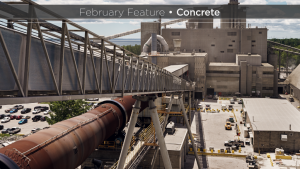Two thousand years ago, the Roman Empire was expanding across much of Europe, creating infrastructure that can still be seen today.
The roads, piers, sewers, dams, aqueducts and buildings necessary for a society to live and thrive would not have been possible without advanced engineering skills. Most famous might be the Pantheon in Rome, a temple completed in 127AD. Its 43.4 metre diameter unsupported concrete dome is the largest in the world.
In addition to design and engineering excellence, little of what the Romans created would have survived over the centuries without a unique blend of concrete that has proven to be more durable than many natural rocks.
The result is what Norbert J. Delatte of Cleveland State University describes as, “a construction system primarily based on cement and concrete that revolutionized construction throughout the Mediterranean basin. Many of their insights and techniques remain applicable today.”
Researchers from MIT, Harvard, Switzerland and Italy examined concrete from the walls of the ancient city of Privernum south of Rome to uncover the chemistry and mixing processes that allowed Roman concrete to endure over time. Their findings were published in Science Advances this past January.
It had been previously assumed the key ingredient in Roman concrete was pozzolanic material, such as volcanic ash from the area of Pozzuoli on the Bay of Naples. This ash was shipped throughout the Roman Empire for use in construction.
However, researchers learned from closer investigation that their wall samples also contained small, distinctive, millimetre-scale bright white mineral features that originate from lime, another key component of the ancient concrete mix. These white chunks, ubiquitous in Roman concrete, are referred to as “lime clasts.”
“Ever since I first began working with ancient Roman concrete, I’ve always been fascinated by these features,” said MIT professor Admir Masic in a MIT release. “These are not found in modern concrete formulations, so why are they present in these ancient materials?”
It was discovered that the white inclusions consisted of various forms of calcium carbonate. Rather than indications of sloppy mixing practices or poor-quality raw materials, it is now suggested these tiny lime clasts gave the concrete a previously unrecognized self-healing capability.
The team also concluded “hot mixing” was another key to the super-durability of Roman concrete.
In hot mixing, quicklime is mixed with the aggregate and then “slaked” with water. The process generates heat. The concrete can be used either immediately as a hot mix or later when cool.
Hot mixing results in two benefits, Masic explained. High temperatures allow chemistries not possible when using only slaked lime and produces high-temperature-associated compounds that would not otherwise form. The increased temperatures also accelerate all reactions, thus significantly reducing curing and setting times, allowing for much faster construction.
During this process, the lime clasts develop a “brittle nanoparticulate architecture, creating an easily fractured and reactive calcium source.”
The researchers believe this creates a self-healing characteristic.
“When tiny cracks start to form within the concrete, they can preferentially travel through the high-surface-area lime clasts,” the MIT release continues. “This material can then react with water, creating a calcium-saturated solution, which can recrystallize as calcium carbonate and quickly fill the crack, or react with pozzolanic materials to further strengthen the composite material. These reactions take place spontaneously and therefore automatically heal the cracks before they spread.”
Tests comparing samples of Roman formulations with modern concrete were deliberately cracked and exposed to water running through the fissures. Within two weeks, the Roman concrete had self-healed preventing further water flow, whereas the modern concrete remained cracked.
Another key difference between Roman concrete construction and that used today is the absence of reinforcing. The deterioration of rebar has been linked to the relatively short life and even the structural failure of modern concrete, due to water ingress that causes the steel to corrode and expand.
Masic is using the team’s research to commercialize concrete inspired by the Romans. He has co-founded DMAT, an American-Italian company that seeks “to develop breakthrough innovations in construction materials at a global scale.”
DMAT’s D-Lime concrete claims to be able to self-heal cracks up to 0.6 millimetres in width, thus reducing further deterioration and maintenance.
However, Masic is not alone in the pursuit of bringing Roman concrete into the present.
The Missouri University of Science and Technology has received research funding from the U.S.-based National Science Foundation to develop new chemistry that mimics the composition of Roman concrete.
Lead researcher Dr. Monday Uchenna Okoronkwo hopes to not only improve strength and durability but also to reduce the carbon associated with concrete production.
“This new material can be as resilient as what was used by the ancient Romans 2,000 years ago, but it will be even better thanks to the modern technology and methods we can now apply.”










This self repairing aspect is very much like adding releasable calcium carbonate particles which is activated by watee. I demonstrated this in my VPI PhD dissertation in 1990
Sounds good but if the calcium deposits are healing themselves it cause they’re breaking themselves into smaller pieces filling in the cracks in between the larger ones, while this keeps the intact appearance, over time will compromise the overall durability of the concrete, a much larger possibility of sudden failure. I think this method would do best in tandem with modern rebar reinforced construction, as an outer layer. Modern concrete may flake and look ugly and require parging to maintain, but it’s still structurally sound. Try subsonically testin ghee pantheon I bet it’s very porous.